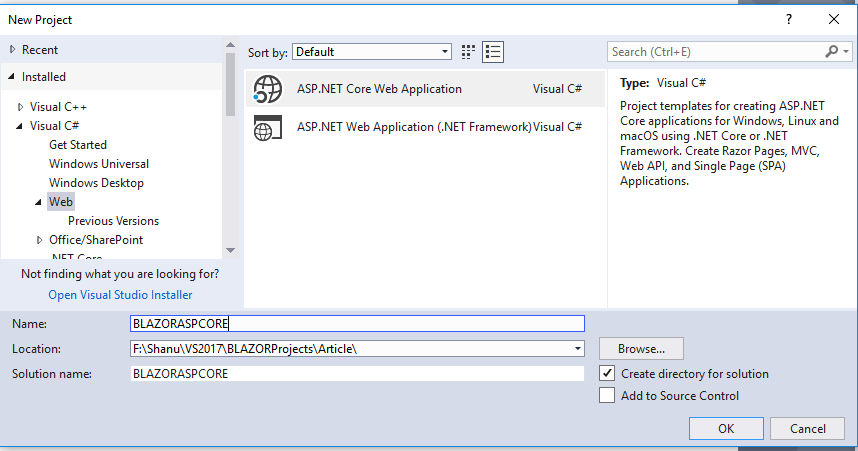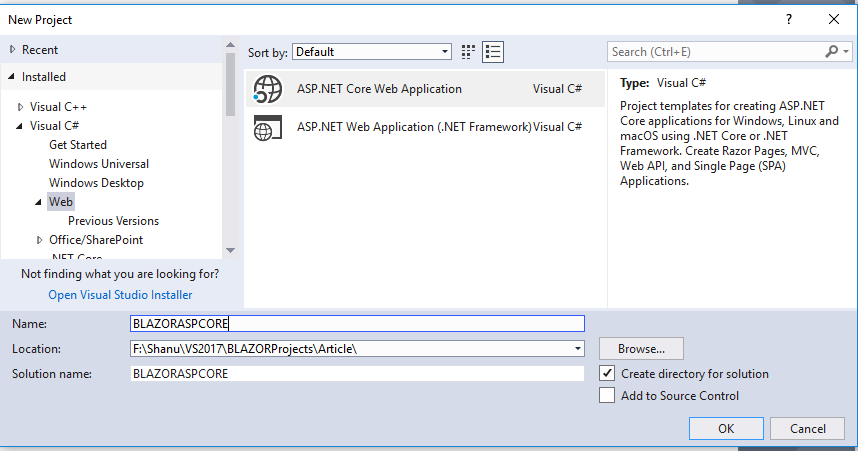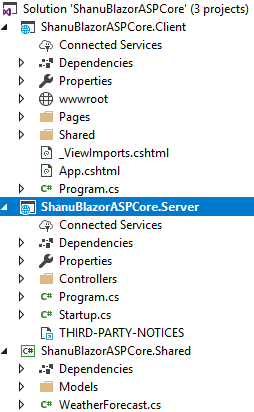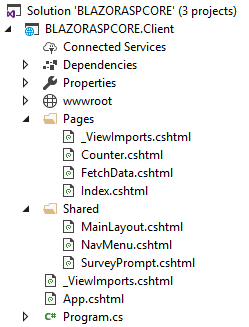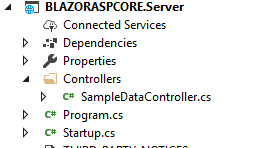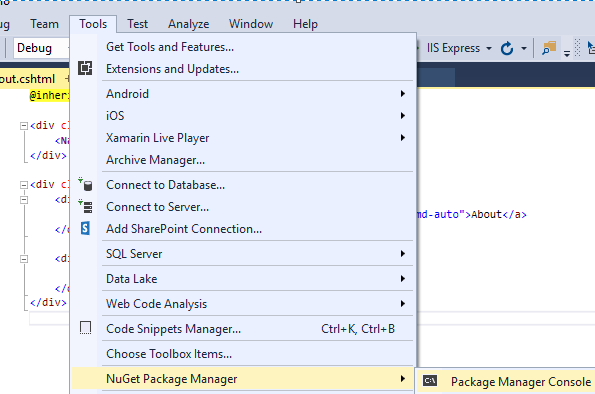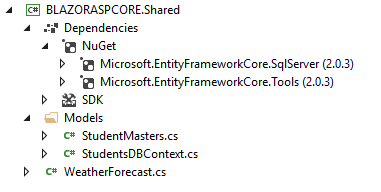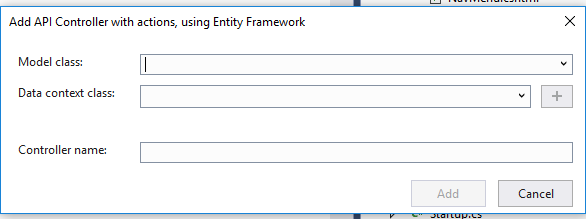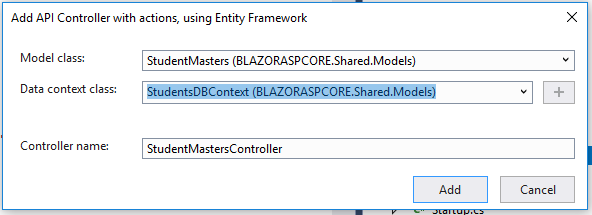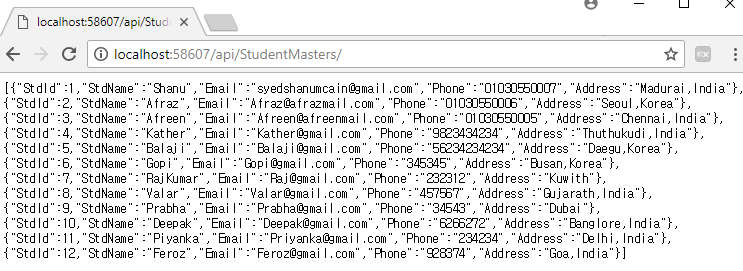ASP.NET Core Blazor Master Detail Grid with Filtering and Sorting using EF and Web API
Introduction
In this article, let’s see how to create our own ASP.NET Core Blazor Master Detail HTML Grid with Sorting and Filtering using Entity Framework, and Web API. We also use the Dynamic Content features of Blazor to create our Master Detail Grid.
This article will explain on: ** **
- Creating a sample database and Student Master and Detail Table in SQL Server to display in our web application.
- How to create an ASP.NET Core Blazor Web application.
- How to install the Package for using Entity Framework and creating a DBContext class.
- How to get a result from Web API and bind result in Blazor client Razor view
- Creating Master/Detail with Sorting and Filtering features for the HTML table
- Creating a Master/Detail table using Blazor Dynamic Content.
Blazor Dynamic Content:
In Blazor we can write our own component using the C# Code. We all know that in Blazor we can write C# code in our client HTML function part, sometimes we need to create and bind the results dynamically to our HTML page. In this article using he Blazor Dynamic Content we create the detail table dynamically and display during the run time as when the user clicks on the detail grid display icon in master grid.
We can also say this as Master/Detail HTML Grid or Hierarchical Grid or Nested Grid.
Why we need Master/Detail Grid
In real time projects like Order Management, Production management, Students Management and etc. we need to display the data in the hierarchical result.
For example, let’s take Students Management project for a University. For students Management, we need to create many relational tables like Student Master, Student Details and etc. In Student Master, we store student ID, Name, Email, Phone, and Address. In Student Details, we store the students' final exam results for displaying Student Major, Studying Year with Term, and Grade details. Both this table will be related with StudentID. We join this both table to display the complete student details.
Initially, we will be displaying all the students Master records in HTML table for view. Users can click on expand icon on each student to view his complete details.
Here, in the below image, we can see that as we bind both the result of Student Master and Student detail in HTML table and we display the detail only when user clicks on the Student Master Icon which is near to the Student ID.when the user clicks on the Student ID “2”, then the next details Grid was being displayed to show student results in detail by Major,Year, Term, and Grade.
Here, we are displaying student details by each student Id.
In our example we also added the Filtering and Sorting functionality for our Master/Detail Grid.
Prerequisites
Make sure, you have installed all the prerequisites in your computer. If not, then download and install all, one by one. Note that since Blazor is the new framework and we must have installed a preview of Visual Studio 2017 (15.7) or above.
- Install the .NET Core 2.1 Preview 2 SDK. (You can find all versions from this link
- Install the latest preview of Visual Studio 2017 (15.7).
- Install the ASP.NET Core Blazor Language Services for Blazor Extensions.
Code part
Step 1 - Create a database and a table
We will be using our SQL Server database for our WEB API and EF. First, we create a database named 'StudentGradeDB'and a table as StudentMaster and StudentsDetail. Here is the SQL script to create a database table and sample record insert query in our table. Run the query given below in your local SQL Server to create a database and a table to be used in our project.
USE MASTER
GO
--1) Check
-- for the Database Exists.If the database is exist then drop and create new DB
IF EXISTS(SELECT [name] FROM sys.databases WHERE[name] = 'StudentGradeDB')
DROP DATABASE StudentGradeDB
GO
CREATE DATABASE StudentGradeDB
GO
USE StudentGradeDB
GO
--1) //////////// StudentMasters
CREATE TABLE[dbo].[StudentMasters](
[StdID] INT IDENTITY PRIMARY KEY,
[StdName][varchar](100) NOT NULL,
[Email][varchar](100) NOT NULL,
[Phone][varchar](20) NOT NULL,
[Address][varchar](200) NOT NULL
)
--insert sample data to Student Master table
INSERT INTO [StudentMasters]([StdName], [Email], [Phone], [Address])
VALUES('Shanu', 'syedshanumcain@gmail.com', '01030550007', 'Madurai,India')
INSERT INTO [StudentMasters]([StdName], [Email], [Phone], [Address])
VALUES('Afraz', 'Afraz@afrazmail.com', '01030550006', 'Madurai,India')
INSERT INTO [StudentMasters]([StdName], [Email], [Phone], [Address])
VALUES('Afreen', 'Afreen@afreenmail.com', '01030550005', 'Madurai,India')
select * from[StudentMasters]
--1) //////////// StudentDetails
CREATE TABLE[dbo].[StudentDetails](
[StdDtlID] INT IDENTITY PRIMARY KEY, [StdID] INT,
[Major][varchar](100) NOT NULL,
[Year][varchar](30) NOT NULL,
[Term][varchar](30) NOT NULL,
[Grade][varchar](10) NOT NULL)
INSERT INTO[StudentDetails]([StdID], [Major], [Year], [Term], [Grade])
VALUES(1, 'Computer Science', 'FirstYear', 'FirstTerm', 'A')
INSERT INTO[StudentDetails]([StdID], [Major], [Year], [Term], [Grade])
VALUES(1, 'Computer Science', 'FirstYear', 'SecondTerm', 'B')
INSERT INTO[StudentDetails]([StdID], [Major], [Year], [Term], [Grade])
VALUES(1, 'Computer Science', 'SecondYear', 'FirstTerm', 'C')
INSERT INTO[StudentDetails]([StdID], [Major], [Year], [Term], [Grade])
VALUES(2, 'Computer Engineer', 'ThirdYear', 'FirstTerm', 'A')
INSERT INTO[StudentDetails]([StdID], [Major], [Year], [Term], [Grade])
VALUES(2, 'Computer Engineer', 'ThirdYear', 'SecondTerm', 'A')
INSERT INTO[StudentDetails]([StdID], [Major], [Year], [Term], [Grade])
VALUES(3, 'English', 'First Year', 'FirstTerm', 'C')
INSERT INTO[StudentDetails]([StdID], [Major], [Year], [Term], [Grade])
VALUES(3, 'Economics', 'First Year', 'FirstTerm', 'A')
select * from StudentDetails
Step 2 - Create ASP.NET Core Blazor Application
After installing all the prerequisites listed above and ASP.NET Core Blazor Language Services, click Start >> Programs >> Visual Studio 2017 >> Visual Studio 2017 on your desktop. Click New >> Project. Select Web >> ASP.NET Core Angular Web Application. Enter your project name and click OK.
Select Blazor (ASP.NET Core hosted) and click ok
After creating ASP.NET Core Blazor Application, wait for few seconds. You will see below structure in solution explorer.
What is new in ASP.NET Core Blazor solution?
When we create our new ASP.NET Core Blazor application we can see as there will be 3 projects will be automatically created in the solution Explorer.
Client Project
The first project created as the Client project and it will be as our Solutionname.Client and here we can see as our Solutionname as “BlazorASPCORE”. As the project named as a client and this project will be mainly focused for all the client-side view. Here we will be adding all our page view to be displayed in the client side in a browser.
We can see that a few sample page have been already added here and we can also see a shared folder same like our MVC application where will be having the Sharedfolder and Layout page for the Master page. Here in Blazor we have the MainLayout which will be work like the Master page and NavMenu for the left side menu display.
Server Project
As the name indicating this project will be used as a Server project. This project is mainly used to create all our Controllers and WEB API Controllers to perform all business logic and perform CRUD operation using WEB API’s. In our demo application, we will be adding a Web API in this Server project and all the WEB API in our Client application. This Server project will be work like get/set the data from Database and from our Client project we bind or send the result to this server to perform the CRUD.
Shared Project
As the name indicating this project work like a shred project. This project works as a Model for our Server project and for the Client project. The Model declared in this Shared project will be used in both the Server and in the Client project. We also install all the packages needed for our project here, for example, to use the Entity Framework we install all the packages in this Shared project.
Run to test the application
When we run the application, we can see that the left side has navigation and the right side contains the data. We can see as the default sample pages and menus will be displayed in our Blazor web site. We can use the pages or remove it and start with our own page.
Now let’s see how to add new page perform the CRUD operation for maintaining student details.
Using Entity Framework
To use the Entity Framework in our Blazor application we need to install the below packages
Install the Packages
Go to Tools and then select -> NuGet Package Manager -> Package Manager Console.
You can see the Console at the bottom of the VS 2017 IDE and in right side of the combobox on the console select the Default project as your shared project” Select Shared”
1) You can see the PM> and copy and paste the below line to install the Database Provider package. This package is used to set the database provider as SQL Server
Install-Package Microsoft.EntityFrameworkCore.SqlServer
We can see as the package is installed in our Shared folder
Install the Entity Framework
2) You can see the PM> and copy and paste the below line to install the EF package.
Install-Package Microsoft.EntityFrameworkCore.Tools
To Create DB Context and set the DB Connection string
3) You can see the PM> and copy and paste the below line set the Connection string and create DB Context. This is important part as we give our SQL Server name, Database Name and SQL server UID and SQL Server Password to connect to our database for performing the CRUD operation. We also give our SQL Table name to create the Model class in our Shared project.
Scaffold-DbContext "Server= ServerName;Database=StudentGradeDB;user id=UserID;password=;Trusted_Connection=True;MultipleActiveResultSets=true" Microsoft.EntityFrameworkCore.SqlServer -OutputDir Models -Tables StudentMasters,StudentDetails
Press enter create connection string, Model Class and Database Context.
We can see StudentMasters Model class and StudentsDBContext class has been created in our Shared project. We will be using this Model and DBContext in our Server project to create our Web API to perform the CRUD operations. ** **
Creating Web API for CRUD operation
To create our WEB API Controller, right-click Controllers folder. Click Add New Controller.
Here we will be using Scaffold method to create our WEB API . We select API Controller with actions, using Entity Framework.
Select our Model and DatabaseContext from the Shared project.
Select our StudentMasters Model from the Shared Project for performing the CRUD operation.
Select the Data Context Class as our StudentsDBContext from the Shared project. Our Controller name will be automatically added if you need you can change it and click the ADD.
We will be using only the Get method from our Web API.
Same like this we also create a Web API for our StudentDetails
To test Get Method, we can run our project and copy the GET method API path. Here, we can see our API path to get api/StudentMasters/
Run the program and paste API path to test our output.
For StudentDetails we can pass the Student ID to get only one student details. Here we can see the result for student ID as “1” we call the Web API as /api/StudentDetails/1
Now we will bind all this WEB API Json result in our Razor View page from our Client project for display the Master/Detail HTML table.
Working with Client Project
First, we need to add the new Razor view page
Add Razor View
To add the Razor view page right click the Pages folder from the Client project. Click on Add >> New Item
Select Razor View >> Enter your page name,Here we have given the name as Students.chtml
In Razor view Page we have 3 parts of code as first is the Import part where we import all the references and models for using in the view, HTML design and data bind part and finally we have the function part to call all the web API to bind in our HTML page and also to perform client-side business logic to be displayed in View page.
Import part
First, we import all the needed support files and references in our Razor View page.Here we have first imported our Model class to be used in our view and also imported HTTPClient for calling the Web API to perform the CRUD operations.
@using BLAZORASPCORE.Shared
@using BLAZORASPCORE.Shared.Models
@page "/Students"
@using Microsoft.AspNetCore.Blazor.Browser.Interop
@inject HttpClient Http
Master HTML Grid data Bind part
Next, we design our Student page to bind the student Master and Student Detail results from the Web API to HTML table.
Binding Student Master Details:
In the Init Method we get the Student Master details from Web API and bind the result in HTML table using foreach loop. Here we bind the result for Student Master Grid and in each row first column we add the Toggle image and, in this Toggle, image click event we call the getStudentsDetails(studentsID) method to display the Detail HTML grid for the related Student. We pass the Student ID to the function and we get the related student details for the student and bind the result in detail grid also we will show the detail grid only when the toggle image button is clicked and if the toggle button clicked again we hide the detail grid.
@foreach (var StudentMasters in stdMaster)
{
<tr style="border-style:dashed;border-width:2px;border-color: @(StudentMasters.StdId == studentIDs ? "#ff6a00": "#a2aabe")">
<td align="center" style="border: solid1px#659EC7; padding: 5px;table-layout:fixed;">
@if (@StudentMasters.StdId == studentIDs)
{
<img src="@Imagename" onclick="@(async () => await getStudentsDetails(@StudentMasters.StdId))" />
}
else
{
<img src="Images/toggle.png" onclick="@(async () => await getStudentsDetails(@StudentMasters.StdId))" /> }
</td>
<td align="center">
<span style="color:#9F000F">
@StudentMasters.StdId
</span>
</td>
<td align="center">
<span style="color:#9F000F">
@StudentMasters.StdName
</span>
</td>
<td align="center">
<span style="color:#9F000F">
@StudentMasters.Email
</span>
</td>
<td align="center">
<span style="color:#9F000F">
@StudentMasters.Phone
</span>
</td>
<td align="center">
<span style="color:#9F000F">
@StudentMasters.Address
</span>
</td>
</tr>
Adding Sorting features in Table Heading
Here we have added the Sorting and Filtering features only for the Master HTML table. If needed then we can implement this same feather for Detail grid as well.
In the Master Table heading part for each heading, we add the Sorting Image. In Sorting Image Button Click event we call the Sorting function and pass each Sorting Column name to the click event. In Function code part we sort the Web API and display the result by ascending and in descending order by each column header soring image click.
<table style="background-color:#FFFFFF; border-style:inset;border-width:1px;border-color:#6D7B8D; padding:2px;width:100%;table-layout:fixed;" cellpadding="1" cellspacing="1">
<tr style="background-color:#2d364d ; color:#FFFFFF ;border-style:dashed;border-width:2px;border-color:0A2464;" >
<td width="30" align="center"></td>
<td width="80" align="center">
<img src="@ImageSortname" onclick="@(async () => await StudentSorting("StdId"))" height="24" width="24"/>
Student ID
</td>
<td width="240" align="center">
<img src="@ImageSortname" onclick="@(async () => await StudentSorting("StdName"))" height="24" width="24"/>
Student Name
</td>
<td width="240" align="center">
<img src="@ImageSortname" onclick="@(async () => await StudentSorting("Email"))" height="24" width="24"/>
Email
</td>
<td width="120" align="center">
<img src="@ImageSortname" onclick="@(async () => await StudentSorting("Phone"))" height="24" width="24"/>
Phone
</td>
<td width="340" align="center">
<img src="@ImageSortname" onclick="@(async () => await StudentSorting("Address"))" height="24" width="24"/>
Address
</td>
</tr>
Adding Filtering features in Table Heading
In the Table heading part we add a new row. In table row we add the Textbox for each column to perform the filtering for the bound result. In Textbox onChange event we call the method to perform the Filtering operation from the code function part
<tr style="height: 30px; background-color:#336699 ; color:#FFFFFF ;">
<td width="30" align="center"></td>
<td width="80" align="center">Filter : </td>
<td width="240" align="center">
<input width="70" onchange=@OnstdNameChanged oninput="(this.dispatchEvent(new CustomEvent('change', {bubbles: true})))" />
</td>
<td width="240" align="center">
<input width="70" onchange=@OnEmailChanged oninput="(this.dispatchEvent(new CustomEvent('change', {bubbles: true})))" />
</td>
<td width="120" align="center">
<input width="70" onchange=@OnPhoneChanged oninput="(this.dispatchEvent(new CustomEvent('change', {bubbles: true})))" />
</td>
<td width="340" align="center">
<input width="70" onchange=@OnAddressChanged oninput="(this.dispatchEvent(new CustomEvent('change', {bubbles: true})))" />
</td>
</tr>
Bind the Detail Grid result
Firstly we check the StudentDetails result is null ,If its not null then we bind the result in HTML Table, Before binding the result we also check for the showDetailStatus ==1 which means to show or hide the Detail Grid. By default, we set the showDetailStatus as 0 and in Master grid Toggle image click event we change the status to 1 and if the showDetailStatus is 1 then we display the Detail grid we also check the Master grid StudentsID with student detail and bind the result in Detail Grid.
@if (stdDetail != null)
{
@if (showDetailStatus == 1)
{
@if (@StudentMasters.StdId == studentIDs)
{
<tr style="background-color:#6D7B8D ; color:honeydew ;border-style:dashed;border-width:2px;border-color:#ECF3F4;">
<td colspan="6" align="center">
Student Details of Student Id - <strong> @StudentMasters.StdId </strong> ,Total @stdDetail.Length Grade details for this Student
</td>
</tr>
<tr>
<td></td>
<td colspan="5">
<table style="background-color:#ECF3F4;border-style:dashed;border-width:2px;border-color:#0A2464; padding:5px;width:100%;table-layout:fixed;" cellpadding="1" cellspacing="1">
<tr style="background-color:#659EC7 ; color:#FFFFFF ;border-style:dashed;border-width:2px;border-color:0A2464;">
<td width="160" align="center">
<Strong>Student Detail</Strong>
</td>
<td width="240" align="center">
Major
</td>
<td width="240" align="center">
Year
</td>
<td width="120" align="center">
Term
</td>
<td width="340" align="center">
Grade
</td>
</tr>
@foreach (var stdDtls in stdDetail)
{
<tr>
<td align="center">
@stdDtls.StdDtlId
</td>
<td align="center">
<span style="color:#9F000F">
@stdDtls.Major
</span>
</td>
<td align="center">
<span style="color:#9F000F">
@stdDtls.Year
</span>
</td>
<td align="center">
<span style="color:#9F000F">
@stdDtls.Term
</span>
</td>
<td align="center">
<span style="color:#9F000F">
@stdDtls.Grade
</span>
</td>
</tr>
}
</table>
</td>
</tr>
}
}
}
Function Part
function part to call all the web API to bind in our HTML page and also to perform client-side business logic to be displayed in View page.
Init Method
In the Init method we get the result of Web API for student details and store it in the StudentMaster object and we using this object to be bind in our HTML table using the foreach statement.
@functions {
StudentMasters[] stdMaster;
StudentDetails[] stdDetail;
StudentMasters stdmst = new StudentMasters();
StudentDetails stdDtl = new StudentDetails();
int showDetailStatus = 0;
int sortStatus = 0;
int studentIDs = 0;
string Imagename = "Images/toggle.png";
string ImageSortname = "Images/sortAsc.png";
protected override async Task OnInitAsync()
{
stdMaster = await Http.GetJsonAsync<StudentMasters[]>("/api/StudentMasters/");
}
Detail Grid bind, Hide/Show method
In the Master grid Toggle image click event we call this below method and pass the studentID to get the appropriate student details from the Web API and bind the result in the detail grid.
protected async Task getStudentsDetails(int StudID)
{
if (studentIDs != StudID)
{
Imagename = "Images/expand.png";
showDetailStatus = 1;
}
else
{
if (showDetailStatus == 0)
{
Imagename = "Images/expand.png";
showDetailStatus = 1;
}
else
{
Imagename = "Images/toggle.png";
showDetailStatus = 0;
}
}
studentIDs = StudID;
stdDetail = await Http.GetJsonAsync<StudentDetails[]>("/api/StudentDetails/" + Convert.ToInt32(StudID));
}
Sorting Method
In Sorting image click on each column heading we call this method and pass the column name to this method. In this method depend on column name we do Sorting the Web API result and bind the result in the HTML table. We also do the vice versa sorting of Ascending and descending.
//Sorting
protected async Task StudentSorting(string SortColumn)
{
stdMaster = await Http.GetJsonAsync<StudentMasters[]>("/api/StudentMasters/");
if (ids == 0)
{
ImageSortname = "Images/sortDec.png";
ids = 1;
switch (SortColumn)
{
case "StdId":
stdMaster = stdMaster.OrderBy(x => x.StdId).ToArray() ;
break;
case "StdName":
stdMaster = stdMaster.OrderBy(x => x.StdName).ToArray();
break;
case "Email":
stdMaster = stdMaster.OrderBy(x => x.Email).ToArray();
break;
case "Phone":
stdMaster = stdMaster.OrderBy(x => x.Phone).ToArray();
break;
case "Address":
stdMaster = stdMaster.OrderBy(x => x.Address).ToArray();
break;
}
}
else
{
ImageSortname = "Images/sortAsc.png";
ids = 0;
switch (SortColumn)
{
case "StdId":
stdMaster = stdMaster.OrderByDescending(x => x.StdId).ToArray();
break;
case "StdName":
stdMaster = stdMaster.OrderByDescending(x => x.StdName).ToArray();
break;
case "Email":
stdMaster = stdMaster.OrderByDescending(x => x.Email).ToArray();
break;
case "Phone":
stdMaster = stdMaster.OrderByDescending(x => x.Phone).ToArray();
break;
case "Address":
stdMaster = stdMaster.OrderByDescending(x => x.Address).ToArray();
break;
}
}
}
Filtering Method
In each column heading part, we have added a new row for performing the Filtering of the HTML grid. In each column filter Textbox Change event we pass the Textbox value. We call a common filtering method studentFilteringList and in this method, we pass the filtering column Textbox value and column Name.
// For Filtering by Student Name
void OnstdNameChanged(UIChangeEventArgs args)
{
string values = args.Value.ToString();
studentFilteringList(values, "StudentName");
}
// For Filtering by Email
void OnEmailChanged(UIChangeEventArgs args)
{
string values = args.Value.ToString();
studentFilteringList(values, "Email");
}
// For Filtering by Phone
void OnPhoneChanged(UIChangeEventArgs args)
{
string values = args.Value.ToString();
studentFilteringList(values, "Phone");
}
// For Filtering by Adress
void OnAddressChanged(UIChangeEventArgs args)
{
string values = args.Value.ToString();
studentFilteringList(values, "Address");
}
Here we create a common function named as studentFilteringList and in this method, we get the filtering column Textbox value and column Name. We do filtering from the Web API and bind the filtering result to the HTML Table.
//Filtering
protected async Task studentFilteringList(String Value,string columnName)
{
stdMaster = await Http.GetJsonAsync<StudentMasters[]>("/api/StudentMasters/");
if (Value.Trim().Length >0)
{
switch (columnName)
{
case "StudentName":
stdMaster = stdMaster.Where(x => x.StdName.Contains(Value)).ToArray();
break;
case "Email":
stdMaster = stdMaster.Where(x => x.Email.Contains(Value)).ToArray();
break;
case "Phone":
stdMaster = stdMaster.Where(x => x.Phone.Contains(Value)).ToArray();
break;
case "Address":
stdMaster = stdMaster.Where(x => x.Address.Contains(Value)).ToArray();
break;
default:
stdMaster = await Http.GetJsonAsync<StudentMasters[]>("/api/StudentMasters/");
break;
}
}
else
{
stdMaster = await Http.GetJsonAsync<StudentMasters[]>("/api/StudentMasters/");
}
}
Razor Page with Dynamic Content
First, we need to add the new Razor view page, To add the Razor view page right click the Pages folder from the Client project. Click on Add >> New Item
Select Razor View >> Enter your page name, Here we have given the name as Students.chtml
Same like our previous Razor view page we use the same logic to bind the Master and the Detail grid but here instead of the direct HTML binding for the Detail grid we bind the detail grid result using the Blazor Dynamic Content. We already saw the Master data binding and Toggle button click events, Now for this page, we will directly explaining only for the Dynamic Content part.
Dynamic Content bind HTML part
Same like our previous page we do all status check and finally bind the Dynamic Content to display the Detail HTML table. We bind the result of Dynamic Content by using @DynamicContent object.
@if (stdDetail != null)
{
@if (showDetailStatus == 1)
{
@if (@StudentMasters.StdId == studentIDs)
{
<tr style="background-color:#6D7B8D ; color:honeydew ;border-style:dashed;border-width:2px;border-color:#ECF3F4;">
<td colspan="6" align="center">
Student Details of Student Id - <strong> @StudentMasters.StdId </strong> ,Total @stdDetail.Length Grade details for this Student
</td>
</tr>
<tr>
<td></td>
<td colspan="5">
@DynamicContent
</td>
</tr>
}
}
}
Dynamic Content bind Function
We bind the Dynamic Content results using the RenderFragment object. Using the RenderFragment (Delegate) in our method we build the dynamic content and bind the result dynamically at runtime.
private Microsoft.AspNetCore.Blazor.RenderFragment DynamicContent;
In the Detail HTML table grid bind method we create the dynamic Content to display the Detail grid inside the Master grid. In the calling method every time we dynamically create the Detail grid and bind the result in RederFragment delegate with the use of builder we create a table dynamically and bind the results.
stdDetail = await Http.GetJsonAsync<StudentDetails[]>("/api/StudentDetails/" + Convert.ToInt32(StudID));
DynamicContent = builder => {
var seq = 0;
builder.OpenElement(seq, "table");
builder.AddAttribute(seq, "style", "background-color:#ECF3F4;border-style:dashed;border-width:2px;border-color:#0A2464; padding:5px;width:100%;table-layout:fixed;");
// Heading
builder.OpenElement(++seq, "tr");
builder.AddAttribute(++seq, "style", "height: 30px;border-style:inset;border-width:1px;border-color:#6D7B8D; background-color:#336699 ; color:#FFFFFF ;");
builder.OpenElement(++seq, "td");
builder.AddContent(++seq, "Student Details");
builder.CloseElement();
builder.OpenElement(++seq, "td");
builder.AddContent(++seq, "Major");
builder.CloseElement();
builder.OpenElement(++seq, "td");
builder.AddContent(++seq, "Year");
builder.CloseElement();
builder.OpenElement(++seq, "td");
builder.AddContent(++seq, "Term");
builder.CloseElement();
builder.OpenElement(++seq, "td");
builder.AddContent(++seq, "Grade");
builder.CloseElement();
builder.CloseElement();
//Tbody
foreach (var stdDtls in stdDetail)
{
builder.OpenElement(++seq, "tr");
builder.OpenElement(++seq, "td");
builder.AddContent(++seq, stdDtls.StdDtlId);
builder.CloseElement();
builder.OpenElement(++seq, "td");
builder.AddContent(++seq, stdDtls.Major);
builder.CloseElement();
builder.OpenElement(++seq, "td");
builder.AddContent(++seq, stdDtls.Year);
builder.CloseElement();
builder.OpenElement(++seq, "td");
builder.AddContent(++seq, stdDtls.Term);
builder.CloseElement();
builder.OpenElement(++seq, "td");
builder.AddContent(++seq, stdDtls.Grade);
builder.CloseElement();
builder.CloseElement();
}
builder.CloseElement();
};
Navigation Menu
Now we need to add this newly added Students and StudentDynamic Razor page to our left Navigation. For adding this Open the Shared Folder and open the NavMenu.cshtml page and add the menu.
<li class="nav-item px-3">
<NavLink class="nav-link" href="/Students">
<span class="oi oi-list-rich" aria-hidden="true"></span> Student Details
</NavLink>
</li>
<li class="nav-item px-3">
<NavLink class="nav-link" href="/StudentDynamic">
<span class="oi oi-list-rich" aria-hidden="true"></span> Student Dynamic
</NavLink>
</li>
Build and Run the APPlication
Conclusion
In this article we have added only one level of Hierarchy of grid, you can extend this to create multilevel Hierarchy of HTML grid. Note as when creating the DBContext and setting the connection string, don’t forget to add your SQL connection string. Hope you all like this article and in next article we will see more examples to work with Blazors and its really very cool and awesome to work with Blazor.
See Also
- ASP.NET Core Blazor CRUD using Entity Framework and Web API
- ASP.NET Core Blazor Filtering and Sorting using Entity Framework and Web API


